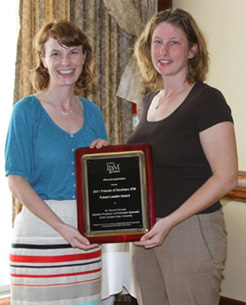NC State Specialist Receives Regional Award at Annual Entomology Meeting
go.ncsu.edu/readext?66498
en Español / em Português
El inglés es el idioma de control de esta página. En la medida en que haya algún conflicto entre la traducción al inglés y la traducción, el inglés prevalece.
Al hacer clic en el enlace de traducción se activa un servicio de traducción gratuito para convertir la página al español. Al igual que con cualquier traducción por Internet, la conversión no es sensible al contexto y puede que no traduzca el texto en su significado original. NC State Extension no garantiza la exactitud del texto traducido. Por favor, tenga en cuenta que algunas aplicaciones y/o servicios pueden no funcionar como se espera cuando se traducen.
Português
Inglês é o idioma de controle desta página. Na medida que haja algum conflito entre o texto original em Inglês e a tradução, o Inglês prevalece.
Ao clicar no link de tradução, um serviço gratuito de tradução será ativado para converter a página para o Português. Como em qualquer tradução pela internet, a conversão não é sensivel ao contexto e pode não ocorrer a tradução para o significado orginal. O serviço de Extensão da Carolina do Norte (NC State Extension) não garante a exatidão do texto traduzido. Por favor, observe que algumas funções ou serviços podem não funcionar como esperado após a tradução.
English
English is the controlling language of this page. To the extent there is any conflict between the English text and the translation, English controls.
Clicking on the translation link activates a free translation service to convert the page to Spanish. As with any Internet translation, the conversion is not context-sensitive and may not translate the text to its original meaning. NC State Extension does not guarantee the accuracy of the translated text. Please note that some applications and/or services may not function as expected when translated.
Collapse ▲
Photograph: Dr. Danesha Seth Carley (right) presenting plaque to Dr. Hannah Burrack (left) during awards luncheon at annual meeting of the Southeastern Branch of the Entomological Society of America in San Juan, Puerto Rico. Photograph by Rosemary Hallberg.
Four years ago, Hannah Burrack started her new job at NC State University as assistant professor with boundless energy and fresh ideas. Last week, the Southern Region IPM Center honored her with their Friends of IPM “Future Leader” award.
The Friends of IPM Future Leader award is designed for an individual early in his or her career who has shown leadership in integrated pest management, or IPM. In its fourth year, the Friends of IPM award recognizes individuals and groups that have exhibited excellence in the field of IPM.
Dr. Danesha Seth Carley, assistant director of the IPM Center, presented Burrack with the award on March 22 at the meeting of the Southeastern Branch of the Entomological Society of America, held this year in San Juan, Puerto Rico. Burrack received the award for her successful monitoring networks of serious pests such as the spotted wing drosophila, and for her early adoption of a blog to communicate news to growers.
Burrack began her career at NC State University in 2007, after graduating with a Ph.D. in entomology from the University of California at Davis. Housed at a research facility in the department of entomology, Burrack specializes in small fruits and tobacco.
Originally from a small town near Green Bay, Wisconsin, Burrack completed her college field work in the labs of the University of Wisconsin. Working with only a 3 month field season, she wanted to move to a warmer climate, where she could broaden her field experience.
“There are a narrow range of field crops in Wisconsin,” she says. “I wanted more variety.”
Her search landed her in California, where she studied recently introduced pests of olives and completed her Ph.D.
Her current position as assistant professor and extension specialist of small fruits and tobacco combines three former positions. She says the combination of tobacco and small fruits has prompted questions from some of her colleagues and clients.
“Federal funding typically doesn’t fund tobacco,” she explains. “So there was a need to bundle that position with other crops. No one knows what tobacco funding will look like in 10 years, so it’s nice to have multiple crops to work with.”
For tobacco, Burrack is currently reviewing old economic thresholds and has developed a web site that tracks the movement of thrips, the insect vector of tomato spotted wilt virus, a devastating disease that also damages tobacco. She is in the process of training tobacco growers how to use the website.
One of her greatest achievements for fruit growers has been her monitoring network for spotted wing drosophila, an invasive pest that has devastated fruit and vegetable crops on the U.S. west coast. The network led to the first discoveries of the pest in South Carolina in early July 2010, and in North Carolina a few weeks later.
Since then, the network has confirmed spotted wing drosophila in 13 locations in the Carolinas.
Burrack is also establishing monitoring networks for blueberry maggot and grape root borer. She posts findings from the networks, in addition to information about workshops, on her blog, “NC Small Fruit, Specialty Crop and Tobacco IPM,” located at http://ncsmallfruitsipm.blogspot.com/.
—
Written by: Rosemary Hallberg, Communication Specialist, Southern Region IPM Center, 919-513-8182 or rhallberg@sripmc.org
Date: March 30, 2011


